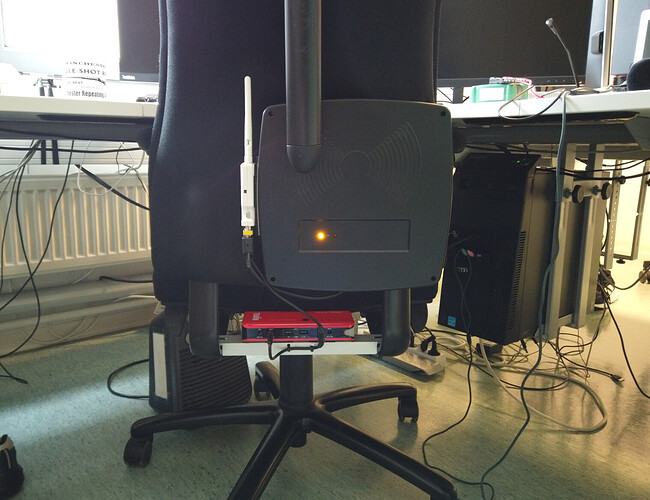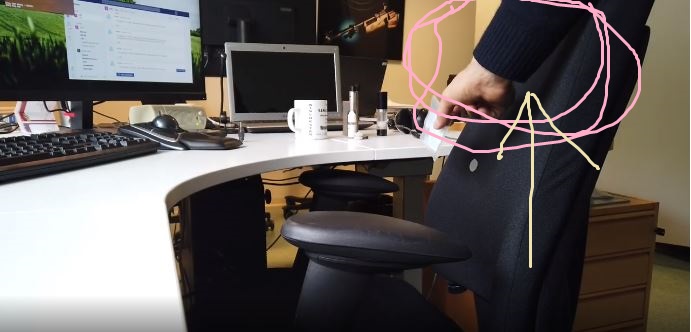![]()
But why on the back?
You can use the place where you rests the arms in the chair to read the chip of your hand or even leave it on the table and unlock your hand.
He covered this. He wants his computer unlocked while sitting in his chair. But he might be soldering or … So he can’t guarantee he will be using the arm rests or have his hand in a given place.
When he stands up it needs to lock, so it is looking for the continual presence of his dorsal implant.
Pretty much what Zwack explained: my ass-chair interface is the only reliable indicator that I’m sitting in it. Of course, a switch in the piston triggered by my weight - or the less-than-perfect sonar presence sensor I used to use - would also do that, but I’d still need to authenticate with my foot implant at least once. That’s, like, work.
With the back implant, the authentication and the sitting status happen at the same time and continuously, enabling a high level of laziness ![]() It’s pretty intoxicating actually: I’m thinking or getting electric blind openers to open the window blinds when I arrive in the morning, and shut them after I leave the chair for more than an hour or something.
It’s pretty intoxicating actually: I’m thinking or getting electric blind openers to open the window blinds when I arrive in the morning, and shut them after I leave the chair for more than an hour or something.
That’s why I really love to work with lazy people - they usually have great ideas to make work more efficient and easy ![]()
Whenever I go to a job interview and the interviewer asks me what I think my strengths are (as they usually do - those lame questions have almost become standard), I literally tell them I’m extremely lazy. Of course that surprises them, and they ask me to elaborate. So I tell them this:
If I was hard worker, I would do this thing you ask me to do, repeatedly, over and over. For instance, if you ask me to fill up a timesheet every month - you know, with hours spent on which cost centers with descriptions - then I’d spend half an hour every day filling up the timesheet. Or I’d go through a test procedure step by step, manually, to perform the tests I’m supposed to perform. Fine: I’d be doing what I’m paid to do and I’d look busy.
But I’m lazy. So whenever I have a task to do more than twice, I’m bored out of my mind. And when I’m bored, I make mistakes. And it wastes my time. So I will spend inordinate amounts of time - even work overtime - automating whatever I have to do once, until I don’t have to do it anymore. And then the stuff I automated will work seamlessly without errors, and I’ll have more time to work on something else - or to slack at the coffee machine.
If you see me slack at the coffee machine, it means my job is done by my scripted minions and it’s done well, and I have free time to take on more tasks than you think I could perform.
So you should hire me, because laziness means efficiency!
That never fails to convince them. Honestly, it really works.
I would hire you.

And now it’s wireless ![]()
The battery is 13,000 mAh and the reader + wifi-RS232 thingamabob draw 110 mA. So in theory, it should almost stay up one full work week on a full charge. Probably won’t though. Still, several days for sure.
You’re seriously an amazing tinkerer ![]()
![]()
And I just love this amazing wire-chaos in the background ![]()
I cannot put how saddened I will be if that is not a black turtleneck…
I just know how to ziptie and velcro stuff together. But thanks ![]()
You can have it… That damn rat’s nest of cable is shameful.
Er… you lost me a bit there bubba. I have no idea what you’re talking about ![]()
Well then, you’ll be happy to know it is my TGIF turtleneck ![]()
I appreciate that. Thank you. Looked well made on the sleeve, had to be something nice like that.
Would it be possible to extend the battery life by adding a pressure sensor and a timer that doesn’t turn it on until weight is put in the chair. Then when pressure is not on the chair it waits 1 hour before turning off again? I’ll bet the entire thing could be done with a 555 timer ![]()
A timer or light sensor might be a better idea.
The problem with those long-range readers is, they go through a boot-up / calibration sequence when they power up: for about 5 seconds, they measure the ambient noise. I found it’s really quite critical that no tag be in the field while they do their calibration thing, otherwise they just don’t work right until you power-cycle them. If I had a pressure sensor on the chair, it would boot up with my implant in the field each and every time.
I might do that at some point. But that’s starting to look like work ![]()
what if you had a low power microcontroller hooked up to a gyro/accelerometer that has programmable hardware interrupts. that way you just bump the chair to start the bootup then wait until it beeps or blinks a light at you. it does seem a little inconvenient for the reader to take so long to boot though.
Well it’s an office chair. A light sensor would work well since the light is on only when I’m at work. Althought it might trigger in the summer with the midnight sun here ![]() Hence my thinking a simple office hour timer would work better.
Hence my thinking a simple office hour timer would work better.
The calibration thing is half of the reason why those readers can achieve long-distance: they need a baseline reading of the environment they’re installed in to better discriminate between noise and signal when a tag comes into the field. They’re heavily influenced by metal around them.
For instance, the one at the back of my chair worked great until I reinstalled the neck rest on the chair. The base of the neck rest is an height-adjustable alu bar that is partially in front of the coil. After I reinstalled it, the reader worked like crap, until I remembered to power it down and back up again, so it would calibrate itself with that piece of metal into view.
Small price to pay for such good performances really.
I am a big fan of the KISS method. ![]()
And… not.
I left it running 24 hours and I found the battery almost dead - meaning whatever voltage converter inside the battery pack uses up 400 mA when the reader and the wifi thing only use 120 mA. That’s disappointing.

